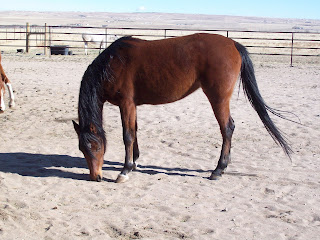Legs is so sweet as he has his heart checked...he is so cute!
Horse skull showing the wolf teeth and the "gap" area for the bit
Pstar nose, you can barely see the wolf tooth but it's right in front of the molars
The speculum (shutter...)
The rasping tool (more shutters...)
The victim (shutter...poor Legs!)
All in all it went pretty quick and it's a necessary maintenance, same as humans going to the dentist. The poor babies though! At least they were sedated for it! I wish I could be whenever I go in for just my cleanings!
Next it was Eksodus's turn. He's just yearling who will turn two in July I think. I hadn't seen him up close in a while, he's almost as big as Pstar is and she's 4 going on 5! What a handsome boy! Since he's still pretty young the vet thought it best just to check his teeth since he still had a lot of baby teeth. His wolf teeth would be removed but the main job today was gelding (castration). I've seen castrations before in Leesburg, VA back in 2000 when I worked as a tech in an equine operating room one summer. Usually the castrations were older horses. I guess doing it in the OR, instead of doing it in the field, was because of the amount of fat and size of the vans deferens.
Handsome boy!
Eksodus was sedated, then given another shot that made him even more sedated to the point where he plopped onto the ground. The vet moved him to a safe location and cushioned his "fall" by holding his head up and then helping him roll down onto his side. It was pretty much the same procedure as in the OR just not with the nice cushioned walls that you wedge the horse in between or with the cool hydraulic table. It was quick and easy though. Make an incision, pull out one testicle, cut the vans deferens and clamp for a few minutes, pull out the next one and do the same. Then the doctor tidied the area up so fat and other skin wouldn't hang out of the wound. It's left open to drain, and the swelling that will then happen helps to close up the wound. I don't remember if they stitched it up in the OR or not but in the field since it's not sterile it's best not to sew up the area. Esksodus then had his wolf teeth removed. Shortly after, he started to get up, he layed on his belly for a little while before fully standing and then was led to stall for 24 hour stall rest with two weeks of hand trotting exercise. It will be interesting to see how Eksodus is as a gelding, hopefully he won't be as nippy with me! He'll be three next year, still very young and compared to Pstar it would be hard to think of buying a three year old I couldn't ride when I could buy and be riding Pstar. 2012 is far away, yet very close....must keep my head in the debt reduction game (aka Project Buy a Pony!)
An iodine scrub to clean the area
Eksodus: "Yikes, that was a horrible dream I just had!"
I was so happy that Laurie let me come out to witness all of this! As a future horse owner I want to soak up as much information as I can to learn about the proper care of horses. I subscribe to Dressage Today, Practical Horseman, Equus and now as a member of the Arabian Horse Association I will be getting their Modern Arabian magazine. Each horse magazine has articles on behavior, training and care of the horse but nothing beats seeing things firsthand! Thanks Laurie! Hope the horses are feeling better after their dental appointments, reminds me I need to get my Jack Russell in for his!
So I'll end this post with a cute pic of Pstar. Awe!












No comments:
Post a Comment